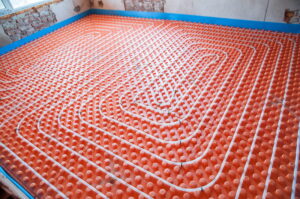Radiant heating systems are boiler-based heaters, which use hot water to distribute heat throughout a house. The boiler heats and distributes water through pipe networks in the walls and subfloors of each room. As the water flows through the pipes, it transmits heats through the pipes and into the rooms. The concept of radiant heating dates back to ancient times, when the Romans would have hot water channeled through canals under their floors.
Despite its long history, however, in modern times radiant heating has been eclipsed in popularity by forced-air systems. This is unfortunate, as modern hydronic radiant heating offers a lot of unique advantages. Let’s take a look at 3 of the major benefits that you can garner from installing a radiant heating system.
Energy Efficiency
Having an energy-efficient heating system is a great way to reduce your home’s operating costs. The average forced-air heating system loses around 20 to 30 percent of its output to leaks in the ductwork, according to the US Department of Energy. Radiant heating uses water pipes instead of ductwork, which enables it to deliver far more of its heat to the target destination. As water is a much more effective thermal conductor than air, a room serviced by a radiant heating system will also heat up faster and stay warm for longer.
Health
Forced air heating systems often negatively affect the indoor air quality of the homes in which they are installed. Airborne contaminants have a tendency to collect in ductwork, and are circulated throughout the house whenever the heater is turned on. Using a forced-air heater too much also has a tendency to dry out the air in the house. These two factors contribute to allergy attacks and illnesses. Radiant systems circulate heat without affecting the air quality inside your home, so you can use them as much as you want without worry.
Comfort
When warm air is pumped into a room, it will immediately rise to the ceiling. As it cools, it will slowly sink to the floor of the room. This creates uncomfortable hot and cold spots in rooms heated by forced-air systems. Hydronic radiant heaters, by contrast, don’t use air as a medium to transport heat. The thermal energy moves directly through solid objects, keeping it near the floor of the room where people are most able to benefit from it.
If you’d like to learn more about the benefits of radiant heating, call Saddleback Plumbing. We provide heating services throughout Orange County.
Continue Reading
Tags: Hydronic Boiler System, Orange County, Radiant Heating
Posted in Heating | Comments Off on 3 Major Benefits of Radiant Heating Systems

